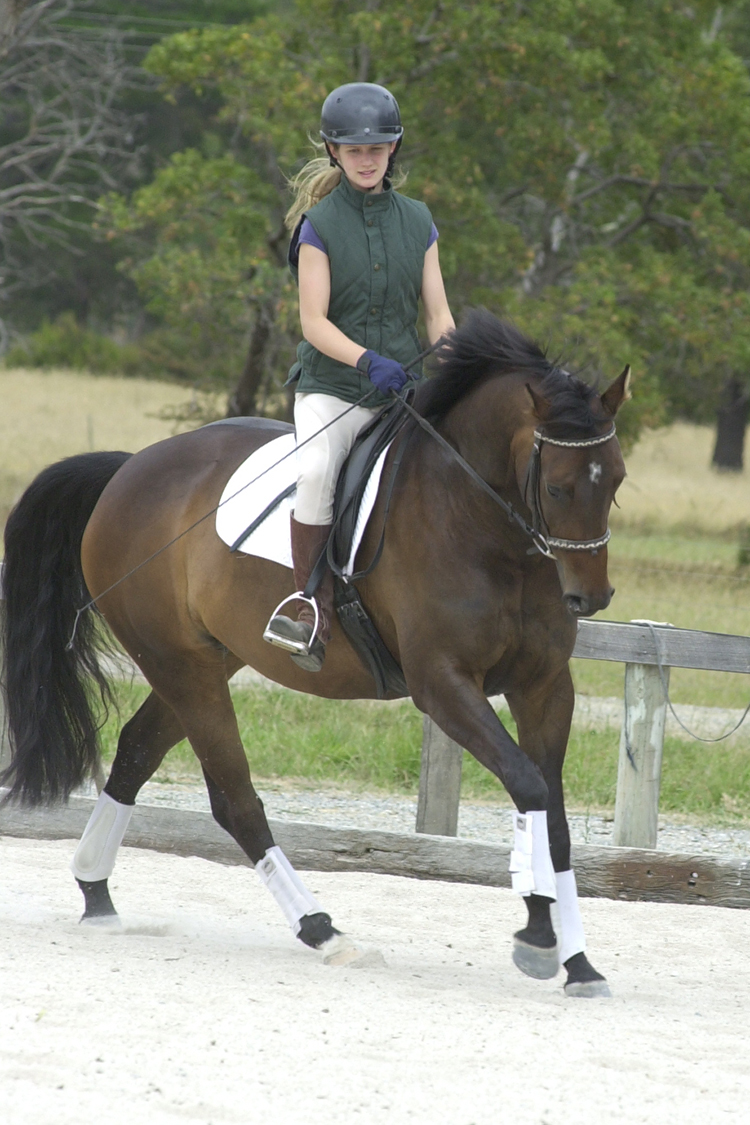 In part one, we met four year old Winsome and her new owner, fourteen year old Laura Rowe. After passing her vet check, Winsome moved straight to Michelle Strapp’s training barn for some initial schooling. It was a wonderful opportunity with Laura home on holidays, able to watch Michelle ride, then hop on and get the good feeling of a well-schooled horse.
In part one, we met four year old Winsome and her new owner, fourteen year old Laura Rowe. After passing her vet check, Winsome moved straight to Michelle Strapp’s training barn for some initial schooling. It was a wonderful opportunity with Laura home on holidays, able to watch Michelle ride, then hop on and get the good feeling of a well-schooled horse.
Michelle with her usual perceptiveness had spotted Winnie’s tendency to roll up and sit behind the aids, and with her usual professionalism, had come up with a series of strategies to open her up.
“She is the sort of horse who likes being the pretty petite lady who doesn’t go anywhere. I’d rather have her a little braver, a little more into the bridle, going forward.”
And as Michelle had observed at the pre-sale test, Winnie tends to curl to the left side. “Horses always have one side that they like to leave long, and one side they like to curl. It’s easy for her to curl to the left, and because it feels good to the rider, they think she is nicely flexed, but really it is a crookedness -because it is harder to stretch a muscle than contract a muscle. So we are working on stretching her left side. As she canters left, I’ll even give .her a bit of a counter flexion. Ride a little shoulder fore to get her hind leg under her.”
“She has a good canter but it tends to be short, so I am careful when I bring her back for a few steps of shorter canter that it is good short canter and I don’t do too much of it. I don’t want a weak short canter and she is still not strong enough to hold it for long.”
“The main thing is that she must go forward. When I ask for a forward trot, if she breaks into a canter from that forward trot, I make it a forward canter, so she gets the confidence to go forward rather than sitting behind the leg.”
It was Michelle who rode the horse first and she lets Winnie tell her the distance for the little jumping exercise:
“What I’ve got set up here is a trot fence down to a blue and white pole. Because she is not very strong in her trot yet, I don’t make the trot fence too big, what I want is a fluent canter stride down to the blue and white pole. So what I’ll do is look for a canter stride that is comfortable for her at the moment. When they start jumping, it’s much better if they can start jumping from a canter that is comfortable for them. It is very hard on a young horse to say, I’m going to start to take short options, when you haven’t even established that canter on the flat. When you try to do that, you sacrifice technique.”
“What we’ll do is the trot fence, and then canter down to the blue and white pole. If that feels a nice fluid canter then we’ll leave the distance as it is, and build a little fence.”
“I want the fence set up with a bit of a ground line – Laura why would she need it?
Michelle freely pays tribute to the influence on her riding and teaching of that wonderful American jumping coach, George Morris, it would seem she has even adopted George’s Q & A approach to lessons – although Laura is spared the withering wit of Mr Morris who is returning to Australia in November- a visit that is long overdue.
Laura is obviously used to being interrogated by Michelle: “She’s only young and she can’t work out how to handle the jumps yet…”
“You are on the right lines. What the ground line does is gives them a little more room to use their shoulder. With young horses, you don’t need to ‘over-suffocate’ them at the base of a fence. The distance is riding a little bit short, then you need the ground rail to just give you a little bit more room, the ground rail encourages them to use their shoulder which encourages them to use their neck and back.”
“You don’t want to have to over-use your hand in front of a fence so you allow the ground pole to help you. It is really important when you school at home that you use your ground rail.”
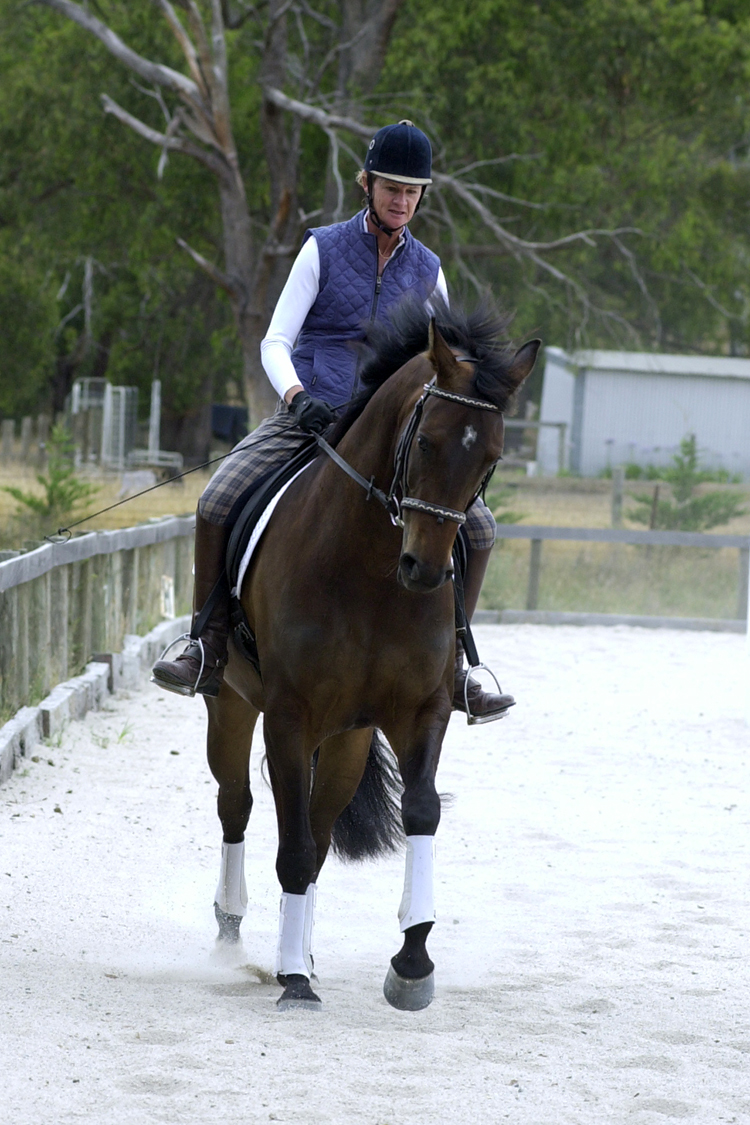
“Now Laura has a horse that she is going to jump, she has to understand what canter is going to give her what stride. I don’t like to put emphasis on picking a stride as such, but riders have to learn to jump a fence from a rhythm. It really helps when they can watch and analyse what kind of canter produces what sort of result. This is a nice five distance, so can you see that I am sitting quiet. The canter has to carry itself. If I made it short, so she had to do it in a shorter canter, then at this stage in her training it would be a bit hard, I’d have to be using clashing aids and I would be making it tight before she even gets to the fence. You’ll have no trouble on this horse adding strides, what we want to concentrate on is keeping her more open. What we’ll do is make the distance just a bit longer, and put up a back rail.”
”I’m not really worried about the jumping. Laura is going away for a week, and I’ll start jumping her over a few bigger fences. The jumping is there, but for Laura at the moment, what is happening is that she is coming from a pony with one canter only, so she has never learnt the timing. Now she has to learn what canter rhythm suits what fence, and learn to assess the distance from the fence from within the canter. That’s the exercise I’ll get Laura to do. As she is approaching I don’t want her to change her canter, but to think where that canter is going to take her. Most kids will canter to a fence and they will have no concept of whether that canter will take them to an open distance or a deeper distance. So you can see the canter is going to take them deep to the fence, but they keep kicking!”
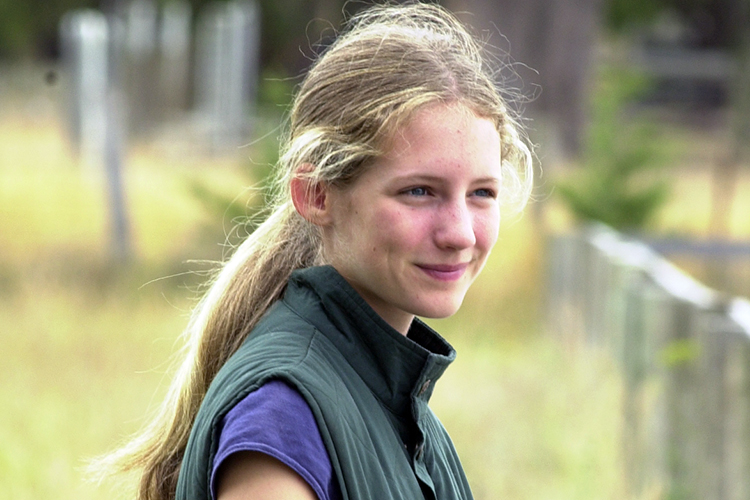
“It’s like you are walking up to the cross rail next to someone and you suddenly push them on their shoulders. They’d fall over the fence! It’s the same with the horse. Someone suddenly kicks the horse two strides out because they have no idea of whether they are long or short! Timing is something that comes to riders through instinct, but if they don’t know what they are looking for they will never develop the instinct”
As any rider knows, the easiest way to get a horse to change is to pop it over a fence. Winnie has been changing lead over the fence out of a left lead, and landing on the right – meaning Michelle has to either come back and change before the corner, or counter canter all the way through the turn at the end of the arena – which is what Michelle does most of the time since counter canter is such a good exercise. I asked when you try teach a young horse to hold the same lead over the fence?
“I sometimes see even senior riders try to change the horse to land on the ‘correct’ lead in mid air. To do that, your horse’s jump needs to be seriously established. The horse’s technique through the air needs to be established or you start to hollow them out, you get them dwelling through the air. Better to let the horse change over the jump then change back again.”
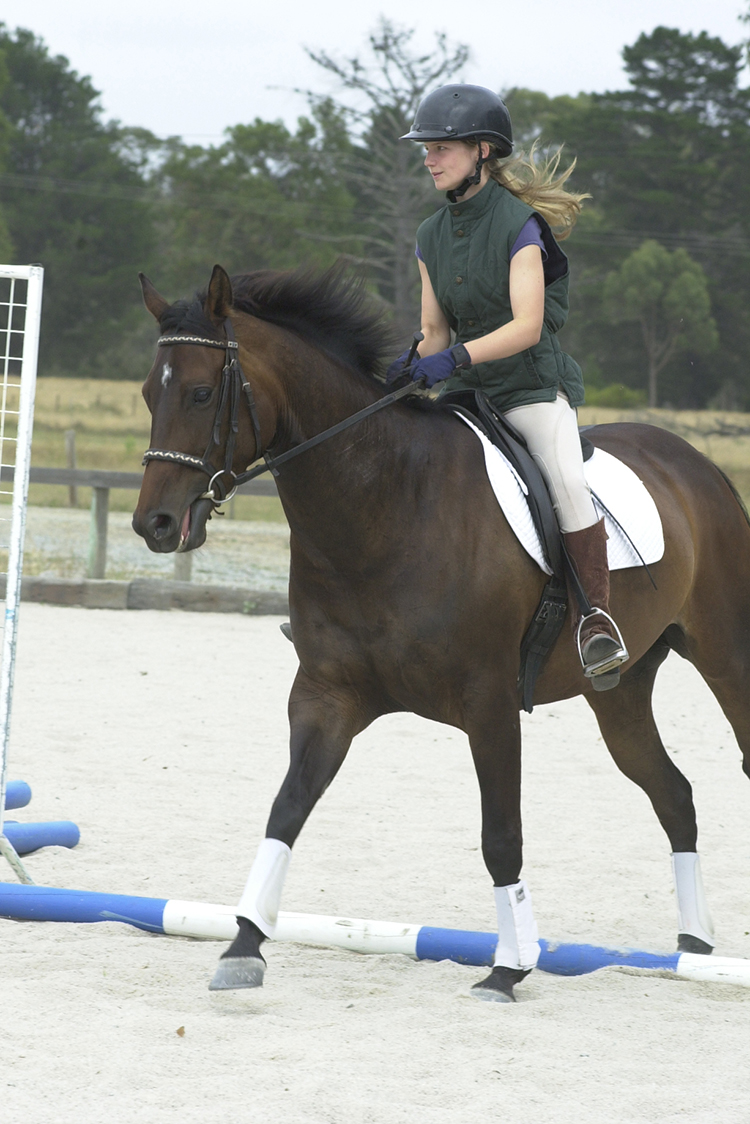
“The most important thing when you teach a horse to jump, is your balance to a fence and your balance after the fence. As I come to a fence I want to make sure I have a straight horse, a good canter, a good rhythm to suit the fence, my first landing stride after the fence will be my first stride to the next fence. With jumping horses, they will within three to six months start to learn flying changes and as they start to learn their changes they will become straighter and stronger in their canter and then they will start landing on the correct lead because they are so beautifully straight. This horse is only a baby and her natural instinct when she leaves the ground is to take herself a little bit to the right, so instinct is to come out on the right lead. As she becomes a little more established in her jump, then I can assist her slightly with rein aids in the air, but if you start to try and influence them with your rein aids in the air before they are established in the jump, you can get them a little inverted. It is never an issue for the horse to come on the correct lead, if it is straight. My whole picture is not what lead she lands on, it’s more how straight she is – and that’s where counter canter is a very good exercise.”
“George Morris once made me jump a full track, at four foot six, in counter canter, to see if I had the balance to do it. With jumping horses, they change leads before you even have a chance to think about it.”
Time for Michelle to get off while there is still some of Winnie left, and for Laura to have her lesson… And do you think Laura got a peaceful five minutes in which to breeze around on her new pony? No way, it was straight down to it.
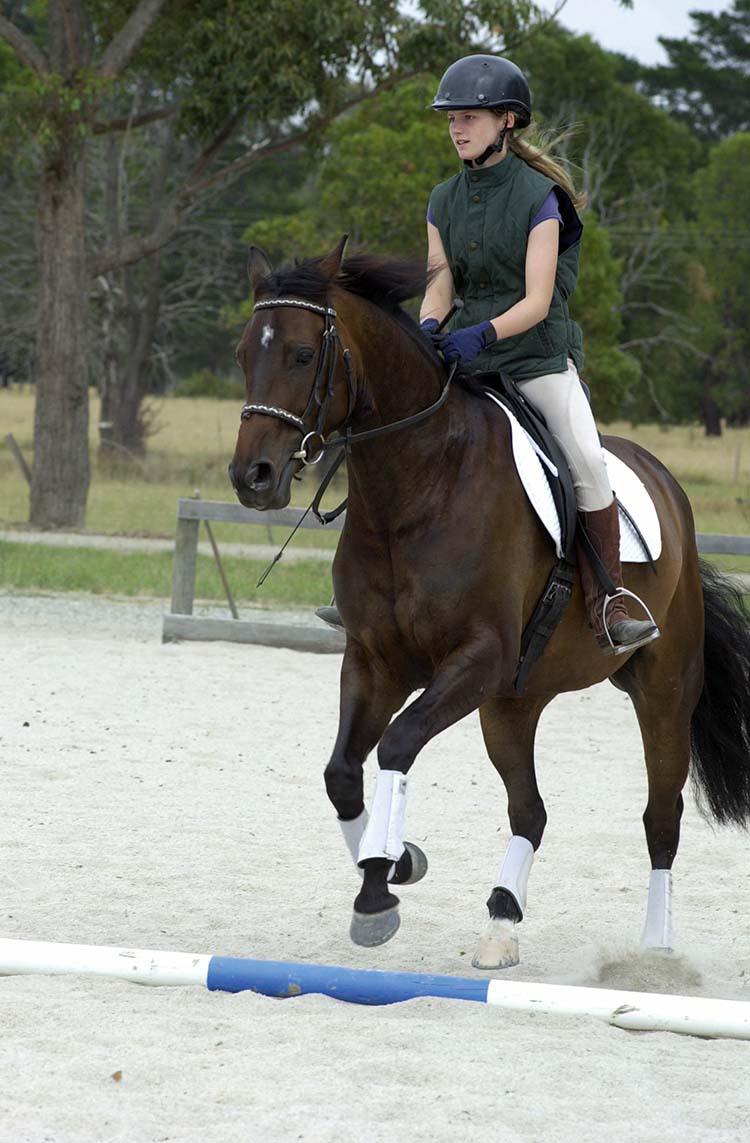
“If she starts to wobble, just trot her straight forward, Big trot, BIG TROT, forward, have a canter, it’s okay as long as it is forward. Now come back to a walk and a free walk. The horse that Laura has come off is always very strong, whereas this horse, her natural instinct is to halt, she just loves to halt, which is perfect for Laura – it means she becomes a seat and leg rider instead of a hand rider. When she wobbles I don ‘t want to say to Laura, connect with right leg, now correct with left leg, correct with right… she is much better off to ride forward. If it starts to wobbly, she is better to canter to the end of the arena.”
“The horse has actually got really nice paces, she just has the mental attitude that she is not sure she wants to go forward which is very natural for baby horses, especially when they are Warmbloods. Where we get into mistakes as trainers is we try so much for pe1fection that we take away the horse’s natural way of going. It is easy to get on and say to the baby horse, you must go exactly into that corner, and we suffocate the pace to ride the perfect line, when actually we should be looking for a blend of both.”
“I push the horse around a little bit, and when Laura gets on she gives her a nice sweet ride, and now the trot is really developing. Now a few big steps, short steps, a few big steps. From BEHIND! When you think big steps, relax your arm and let her forward. This is a better frame now she is working in, more open – it is really important this horse has an open frame. Now bigger trot, allow the elbow, be elastic in the elbow but have enough feel on the reins.”
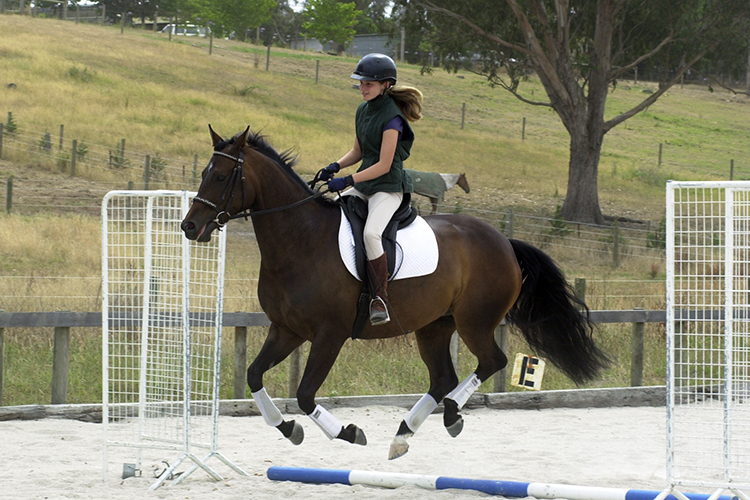
“Systems are all the same, but depending on the horse you have to vary them. To ride this horse with her head on her chest would not suit, she’d love it, that’s her comfort zone.”
“Now a very very slight shoulder fore, very slight. Now make her straight; both hind legs follow the shoulders, head to the centre of her chest. As soon as she wants to curl back, some bigger steps. Again, inside leg, think a little shoulder fore. Inside leg to outside rein so you get the inside leg a little more under her, and she can’t curl that inside hind leg at you. As soon as she gets distracted, use your shoulder fore. You’ve got a few tools there to use now.”
“Come across the diagonal with a few bigger steps. Think big from behind, really straight horse, it’s no good asking for bigger steps before she has the hind legs following the shoulders.”
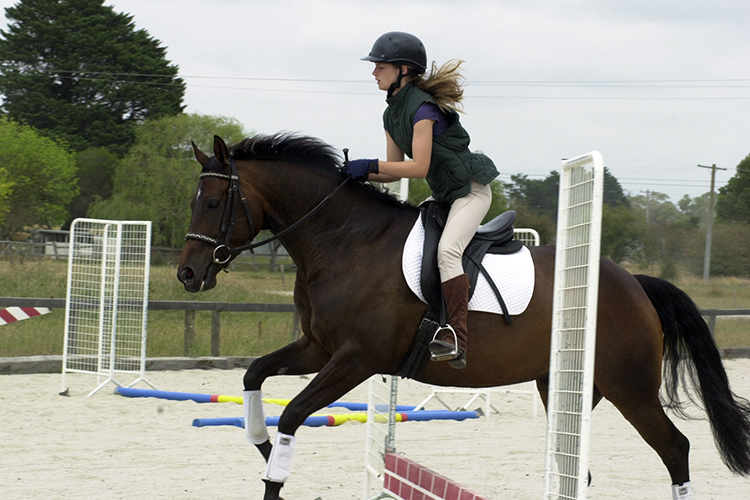
And it is back into Q & A mode… What did she try to do with her body when she came across the diagonal, Laura?
“She tried to bulge to the left. ”
So what is your correction?
“Put my left leg on… ”
And the rein aids?
“Left rein.”
What did the left rein do?
“Sorry right rein!”
Yes, right rein, we had a 50:50 chance of that… If you are pushing her left shoulder out, which way did you have to take her shoulders?
“To the right.”
That‘s right. Your left rein is supporting and you can use a right opening rein. You elbow does not come back, your rein aid does not come back, you just guide her with the rein aids and support the leg. Let the rein go long and walk for a minute and then we’ll try some canter work.
The next exercise is a really tough call for Laura. As she approaches the first pole she has to call out whether the stride will be long or short to the pole. Not adjust the stride, just recognize how it is going to get her to the pole…
What was that?
“Short-Long… ”
We get a lot of those.
But the next try is more decisive.
“Short!”
“That’s right, it’s better than the other day when we got a lot of short/longs. It is a very simple exercise but it is amazing the timing that is required to assess it. The fence is irrelevant, if she can actually canter in a rhythm, keeping the horse straight, and know if she is a little long or a little short, the jump is there. When you are assessing a fence you actually assess from the top of the fence, but when you are assessing a pole it is a bit like if you are walking and you see a puddle, you know not to step in it without having to look down. The rider should still be looking ahead where she is going. What this is developing is the instinct of what you have to do when you are coming to the fence. When you are a little bit long what is the instinctive reaction that has to come naturally?”
CLUCK!
“That’s right cluck her up, that will mentally get you to follow the distance. Make a cluck if you are going to be a bit long – now if you see that the distance is going to be a little bit to the base of the pole, what’s the reaction then?”
WHOA.
“That’s right. Don’t do anything with your hands, just say ‘whoa’. You are waiting with your body, waiting with your eyes, and you are waiting with your mental attitude. A little bit long, cluck, a little bit short, whoa.”
“Keep the elbows elastic. That’s the canter you have chosen, keep it, don ‘t complicate things. Aaah you clucked when it should have been whoa! That’s why this exercise is so good – and you can do a hundred poles a day. The exercise is so good for canter.”
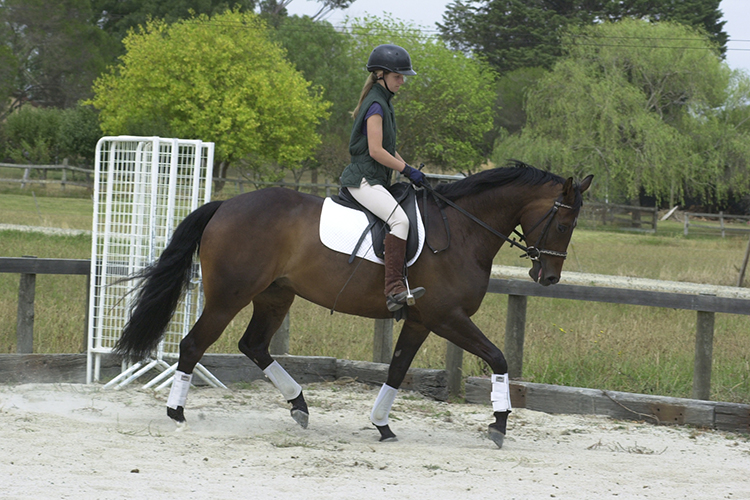
“Great, you clucked just at the right time, and supported the canter that little bit more to make the distance.”
“That should have been a whoa, if it had been a fence and you clucked, you would have suffocated her front legs.”
“Give her a walk on the long rein. I keep forgetting her age, she is only four, her attitude is amazing. She’s sensitive which makes her ideal for Laura.”
“Now down to the little dazzle board, and ride it exactly the same as you ride your poles, no different. If she lands on her right lead, just ride a straight line and come back to a trot before you go through the corner. It is really important that you keep her straight on landing so she learns to land and travel forward. Trot, a little shoulder fore, clear the neck to the right so he is a little softer.”
“Good – canter. A little shorter for a stride and do a short release for me. Now a little half halt again. That’s the canter – assess within the canter. Shorten the reins a little. Canter it· as if it was a pole, it’s no different.”
And of course, Winnie knocks it down; not that it worries Michelle.
“It’s fairly irrelevant to me when the baby horse has the odd rub, especially for the job this horse has to do. When they are doing a lot of poles they are obviously not having to get very elevated, but what is really important is that we get harmony in the canter to the fence between Laura and the horse. It won’t matter what fences I put to this horse. The other day I was jumping a few bigger fences and she made one mistake – and she wasn’t going to make another one! That part of the jumping is not an issue. It is getting the harmony to the fence, and after the fence, and the height of the fence will grow very fast. If you have a young jumper that can give you four different canters to a fence, then you can easily go from a metre to a metre twenty – it is not even an issue.”
Time to end the session but just as we started, we finish correctly…
“Now let her right down, right to the sand, keep your fingers closed on the rein, remember your elasticity is not from open fingers its through your arms… don’t cross your rein over the neck. Ride with eyes and legs. Get her nice and deep, ask her more, take a little feel and show her the way. If she comes above the bridle do something about it – it’s being constructive with elasticity, but you have to have a bit of feel, put her down. And ride off the wall- you are letting the wall be your aids now. Right down, use your opening rein so your chute opens a bit and get her even deeper, she has to stretch all her back – there you can find the feel by opening your hand, not by pulling the elbow back, you can get horses much deeper that way. Without sticking your lower leg forward, open your knee angle, sit down and just use your voice and walk. Lovely… ”
And it was.



